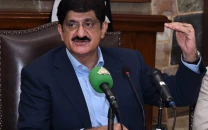Devil in the details: $5.7b ‘discrepancy’ leaves debt office clueless
State Bank figures include short-term borrowing; catch finance ministry off-guard.

The office in the finance ministry charged with keeping track of Pakistan’s total debt and liabilities appears to have no clue about government’s short term borrowing activity in the local bond market and was unable to explain an apparent $5.7 billion discrepancy between the amount of loans that the finance ministry claims it paid back and the repayment numbers tracked by the central bank.
According to the State Bank of Pakistan, the government paid back $7.8 billion in principal on public debt during the fiscal year that ended June 30, 2011. The finance ministry’s figure for the same category is $2.2 billion.
The discrepancy came to light during an internal meeting at the finance ministry, headed by Finance Secretary Waqar Masood. Sources said that, to the shock of all of the officials present, the Director-General of the Debt Office, Masroor Qureshi, appeared to be completely unaware of the discrepancy.
(Read: Fiscal impropriety - If we cross the debt limit quietly, nobody will notice)
This is the second time in recent weeks that the Debt Office’s claims on the nation’s financial liabilities have been called into question by the State Bank.
Earlier, the central bank had come up with figures for Pakistan’s overall debt and liabilities that were much higher than those declared by the finance ministry.
The main source of the discrepancy appears to be about $4.9 billion in short term borrowing from local banks. The maturity on all of these loans was less than one year. However, the finance ministry appears to be completely unaware about this borrowing.
S M Husnain Bukhari, a senior official at the State Bank, said that most of this money was borrowed for liquidity management purposes, with some even being borrowed overnight.
He added that he was not surprised that the figure was not reflected in the finance ministry’s documents. He did, however, add that the central bank’s figures were accurate and reflected a true picture of the country’s financial affairs.
The debt office’s management of the government’s liabilities have been called into question in recent month as the government has been forced to retire much of its long term debt and exchange it for short term liabilities, exposing the government to interest rate shocks. About Rs3 trillion of the government’s Rs10.8 trillion in debt is short term and that proportion seems set to increase.
Statistics released by the economic affairs division of the finance ministry state that Pakistan paid back $1.9 billion in foreign loans about $253 million in loans to the International Monetary Fund, bringing total principal repayments to above $2.2 billion. Interest payments on foreign debt during fiscal year 2011 came to $810 million.
(Read: IMF programme - ‘We tried, we failed, we give up’)
The central bank’s data shows that Pakistan returned $980 million to multilateral creditors like the World Bank, the Asian Development Bank and the Islamic Development Bank. Another amount of $232 million was to Euro and sukuk global bondholders and $179 million to the Paris Club – a group of bilateral creditors.
In addition to these payments the country managed to get rescheduled $1.5 billion loans during the last financial year. The major rescheduling of $1 billion was of the central bank deposits deposited by Saudi Arabia and China. The Finance Ministry also managed to secure the rescheduling of $388 million in loans from the Islamic Development Bank.
Published in The Express Tribune, September 5th, 2011.



















COMMENTS
Comments are moderated and generally will be posted if they are on-topic and not abusive.
For more information, please see our Comments FAQ